by Shawn R. Lyons
All winter long and well into the spring, backcountry skiers from Palmer and Anchorage to Seward and Homer make the pilgrimage to Manitoba Mountain. Regardless of the day of the week—or even regardless of the hour of the day—one can look up from Seward Highway at about mile 50 (just north of Lower Summit Lake) and see them carving up the west-facing slope of the mountain. Even on these rare days when no skiers dot the slope one can still make out the chaos of tracks that scar the snow. Still as popular as Manitoba area remains today as a ski destination, not too many decades ago it may have proved even more popular—because of the tow rope and lodge that once drew other people to the area.
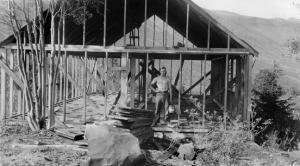
Working on the Manitoba ski area lodge in the summer of 1942 (Clarence “Buster” McClellan)
The origin of the idea of a ski slope had its beginning in the first months of the 1940s. Throughout the first half of 1941 gold mining, which had gone into a decline for many years all over Kenai Peninsula, got a second wind—but only momentarily. Then the looming presence of war in the second half the year changed everything. Even before the bombing of Pearl Harbor on December 7 a variety of restrictions and increased costs sucked this second wind out of gold mining. Of these, the increasing cost of labor and the government’s suppressing the mining of gold (simply because it needed other metals to arm and supply nations already at war with the Axis Powers) hit the miners on the Kenai particularly hard.
But the war effort created other opportunities for those with imagination and will. Sensing such an opportunity possibility, Gentry Schuster decided to build a ski area on the shoulder of Little Manitoba Mountain on Kenai Peninsula. Though his ski area did not thrive for many years, it did mark the first clearly recreational use of the area.
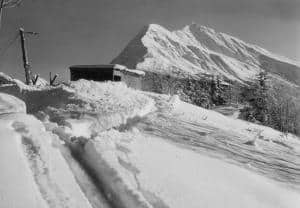
The ski lodge on the slope of Little Manitoba
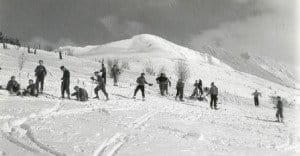
People on the slope’s of the Manitoba ski area in the 1940s (Clarence ‘Buster’ McClellan)
Not that the area had not seen recreational use before the building of this ski area. Already, by the late 1930s the area no longer drew not just miners but recreationists as well. Some of these newcomers built new cabins—like Manitoba Cabin. Others just passed through on the newly built highway—which then consisted of but the dirt road that now parallels the present-day highway—to sightsee on their way to Hope. But these early tourists had no specific place to stop and play. Schuster sought to give them such a place. His ski area would mark the first clearly recreational use of the area.
But even before statehood and its big bureaucracy, Schuster could not just build his resort. He first needed a permit On October 22, 1941 Gentry Schuster of Seward applied to the Forest Service for a Special Use Permit to build a rope tow and “ski hut” at tree line on the south-facing shoulder of Little Manitoba. The next and biggest chore came next: building the lodge and tow rope. This meant first getting the materials from Seward to just north of Lower Summit Lake near mile 50 on Seward Highway. From there the bigger problem involved getting the building materials up to the base of the mountain—a distance of about 1.5 miles. After enlisting the help of a number of hopeful skiers, Schuster devised two methods of moving the materials up the mountain: first, a rope tram powered by a Ford engine; second, the old-fashioned method of piling it on one’s back and packing it up.
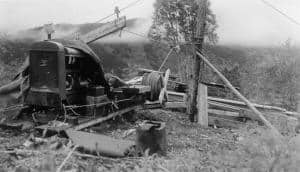
The Ford Model A engine used as a tram to haul materials at the Manitoba ski area (Clarence ‘Buster’ McClellan)
Though the first method proved most efficient, it had its moments of unreliability. During the hauling of one load up the tram, the engine gave out and gravity took over control. The men at the bottom of the tram had all they could do to get out of the way of the whizzing load before it crashed and shattered the loading area. The men just picked themselves, rebuilt the tram, and started moving loads up the mountain once more.
Working diligently, Schuster and his team had finished not only the tow rope but also a hut up on Little Manitoba by the summer of 1942—not an easy task considering he had a day job in Seward as chief operating officer of the Seward dock. But he also had the regular help of Clarence ‘Buster’ McClellan, who seems to have taken an active and near-constant role in the work.
But even after completion of the lodge and tow rope, they needed to find means of bringing the needed power, fuel, food, and other goods to the site. Providing the power proved relatively easy: Once he didn’t need the tram anymore, Schuster used the Ford engine that had powered the tram to power the rope tow. Schuster then plowed out a small landing strip just above the cabin in the hopes that he could ferry supplies up the mountain in his Piper Cub. But, alas, the small plane could not carry big enough loads to make it feasible.
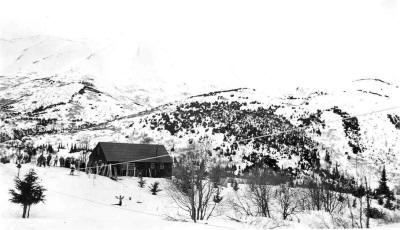
Looking at the Manitoba ski area lodge and further south across the Mills Creek drainage (Virginia Schuster)

Inside the Manitoba ski area lodge (Virginia Schuster)
He christened the hut Glacier Ski Lodge, though pictures show it less a lodge and more an over-sized cabin with two bedrooms, a dormitory that slept eight, a loft in which to unroll sleeping bags, a closed-off kitchen with a great cast-iron stove, and a root cellar mostly used to store canned goods. But such a hut would’ve proved more than adequate for Schuster’s original intention of opening it only to the use of his family and friends. But with the coming of World War II to Alaska, and the stationing of 5,000 troops in Seward alone, Schuster could not turn away the many new skiers among these new Alaskans.
Before long, people drove from many miles away for a day of skiing on Little Manitoba. As old photos show, these skiers included many military personnel. Soon Manitoba proved a place not just for skiing but for social gatherings and parties. But because of his day job, Schuster could only open the lodge on weekends, when many people would drive up to the lode for a day on the slope.
Schuster’s wife Virginia recalled one Sunday when she served a cooked lunch of roast beef, mashed potatoes and gravy, and coleslaw to sixty-seven people—which meant cleaning and re-setting the dining room (which sat only twenty) four times and then washing all the dishes with melted snow. Not surprisingly, after that, she only served cold lunches.
And though Schuster allowed no liquor at the cabin or on the slopes, he could not police his policy in person for most of the week. One can only imagine his fuming over finding thousands of empty beer cans in the loft after the war.
By that time, though, Schuster had turned his mind to other things. Earning his license for flying and had begun flying commercially and even began his own business, Safeway Air, in Anchorage. His marriage also went into decline after the war. With all these other ventures and concerns, Schuster eventually gave the lodge and tow rope to Oliver Amend in 1955. This transfer consisted of no contract or exchange of money. According tm Mrs. Schuster, her husband just said to Amend, “you take it.”
Amend started by making a number of improvements. For one, he built the switch-backed road that leads from Manitoba Cabin up to Manitoba Mountain—the same trail skiers and hikers use to this day. He also offered rides from the highway up to the lodge on his “Weasel”—a tracked surplus vehicle he had picked up from the military after the war. Business proved so good that that increased parking on the highway led to the highway department building the mile 48 turnout that people also still use to this day to ski, hike, and/or stay at Manitoba Cabin.
To accommodate the growing crowds Amend also built two more rope tows—one of which stretched 300 feet up the mountain. Amend charged $2 to haul a skier up the hill and another $3 to ski all day. On top of this, Amend’s wife Cecilia cooked meals. On one especially busy weekend Amend counted 300 skiers that had come and gone.
But like Schuster, Amend had a day job, which meant that people used, and often abused, the lodge. (Amend blamed the military skiers for most of these abuses.) They would even use the Weasel and made themselves at home in the lodge. Amend tried stopping them by gating the road and partially dismantling the rope tows, but these precautions did little to stop the intruders. Eventually things got so out of hand, that some of these trespassers—whether by accident or design—burned the lodge down in 1960.
Seth Pasquale who conducted an archaeological study of the sight n 2005 actually found and talked to Oliver Amend by phone. In doing so, he learned much about the lode and rope tow. But Schuster had long since died. Diagnosed with cancer in the mid-1960, he died on May 3, 1967, and now lies in Forest Lawn Cemetery in Cypress, California.
But though the lodge has long-since burned down, one can still, if one searches diligently enough amongst the brush and grasses, scrounge up some remnants of the lodge and the rope tows—reminders of other times and other people recreating in the mountains above the Summit lakes. On top of Little Manitoba one can even come across a frame of wood imbedded in the ground that once served as the uppermost end of one of the tow ropes. A 55-gallon drum nestling in the crook of two limbs of a tree beside the road just below the site may have also served as a runner on which to lay one of the ropes.
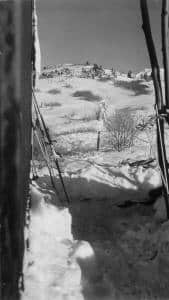
Looking up the tow rope from the cabin (Clarence ‘Buster’ McClellan)
But though little remains of Schuster’s and Amend’s ski area, skiing still goes on—not only on Little Manitoba but also on the higher Manitoba Mountain behind it. The faces and equipment have certainly changed, but the urge to cut up some snow has not, as anyone who looks up from the highway below or takes the effort to climb up onto can certainly see for themselves.
Author’s Note: For those with further interest in this historic ski area, they might have some interest in knowing that Chugach National Forest archaeologist Seth DePasqual performed an archaeological study of the lodge site during the summer of 2005, and some photos from the relics he discovered are available on the Alaska Lost Ski Areas Project Website.)
Enjoy these articles? Sign up for our monthly newsletter to be sure to see them or follow us on Facebook or Instagram. Sign up below!
–Shawn Lyons has published five hiking guides to Southcentral Alaska. He has won the Iditashoe wilderness snowshoe race nine times, and the 100-mile Coldfoot Classic three times. For many years Shawn wrote a weekly hiking/climbing column for The Anchorage Daily News.
